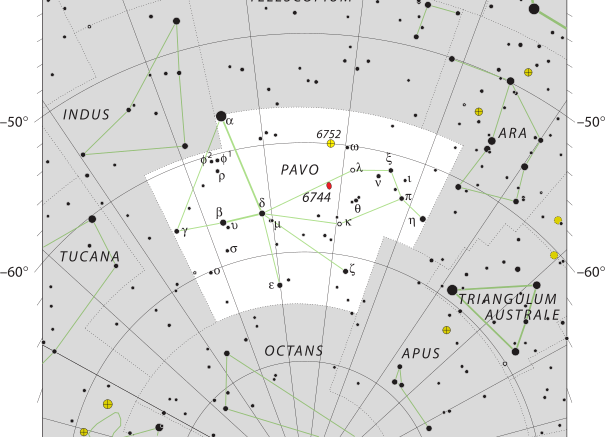Pavo is a constellation in the southern sky whose name is Latin for “peacock” that first appeared on a 35-cm diameter celestial globe published in 1598 in Amsterdam. It would later be depicted in Johann Bayer’s star atlas Uranometria of 1603, and was likely conceived by Petrus Plancius from the observations of Pieter Dirkszoon Keyser and Frederick de Houtman. The french astronomer Nicolas-Louis de Lacaille gave its stars Bayer designations in 1756. The constellations of Pavo, Grus, Phoenix and Tucana are collectively known as the “Southern Birds”.
Pavo remains below the horizon at latitudes north of the 30th parallel in the Northern Hemisphere, but is circumpolar at latitudes south of the 50th parallel in the Southern Hemisphere.
The constellation’s brightest member, Alpha Pavonis, appears as a 1.91-magnitude blue-white star, but is actually a spectroscopic binary. Six of the star systems in Pavo have been found to host planets. The constellation contains NGC 6752, the third-brightest globular cluster in the sky, and the spiral galaxy NGC 6744, which closely resembles the Milky Way but is twice as large.
| Applicable Information | |
| Visibility In Pacific Northwest | Not visible in the Pacific Northwest |
| Best Times To View | Not visible in the Pacific Northwest |
| Right Ascension | 18h 10.4m to 21h 32.4m |
| Declination | −56° 35.4′ to −74° 58.8′ |
| Area | 378 square degrees |
| Main Stars | 7 |
| Brightest Object | α Pav |
| Meteor showers | Delta Pavonids |
| Messier objects | 0 |
| Neighboring Constellations | Octans, Apus, Ara, Telescopium, Indus |
History
In Greek mythology, the peacock was Hera’s sacred bird. The goddess drove through the air in a chariot drawn by peacocks. There is a myth specifically associated with the peacock’s tail and how it came to have eyes on it.
It is uncertain whether the Dutch astronomers were thinking of the Greek mythology when creating Pavo was created. But the “peacock” in the new constellation likely referred to the green peacock, which the explorers would have encountered in the East Indies, rather than the blue peacock known to the ancient Greeks.
In the Australian Northern Territory, the Wardaman people saw the stars of Pavo and neighboring Ara as flying foxes.
Stars
Bayer did not assign its stars Bayer designations when he depicted on his chat of Pavo. French explorer and astronomer Nicolas-Louis de Lacaille labelled these stars Alpha to Omega in 1756, but omitted Psi and Xi. In 1879, American astronomer Benjamin Gould designated a star Xi Pavonis as he felt its brightness warranted a name, but dropped Chi Pavonis due to its faintness.
Six stars with planetary systems have been found. 3 planets have been discovered in the system of the orange star HD 181433, which is an inner super-earth star. HD 196050 and HD 175167 are yellow G-class Sun-like stars, while HD 190984 is an F-class main sequence star slightly larger and hotter than the Sun. HD 172555 is a young white A-type main sequence star, two planets of which appear to have had a major collision in the past few thousand years.
Deep-sky objects
The deep-sky objects in Pavo include NGC 6752, the third-brightest globular cluster in the sky, after 47 Tucanae and Omega Centauri. An estimated 100 light years across, it is thought to contain 100,000 stars.
Lying three degrees to the south of NGC 6752 is NGC 6744, a spiral galaxy around 30 million light years away from Earth. NGC 6744 is said to resemble the Milky Way, but is twice the diameter. NGC 6810 and NGC 6872 lie 87 and 212 million light-years away from Earth respectively.
Meteor showers
Pavo is the radiant of two annual meteor showers: the Delta Pavonids and August Pavonids. The Delta Pavonids can be seen from March 21st to April 8th of each year, with the peak normally being around April 5th and 6th. The August Pavonids peak around August 31st.
Make sure to check out other articles on the site, including a brief introduction to constellations, other constellation articles, and more!

Be the first to comment on "Pavo"